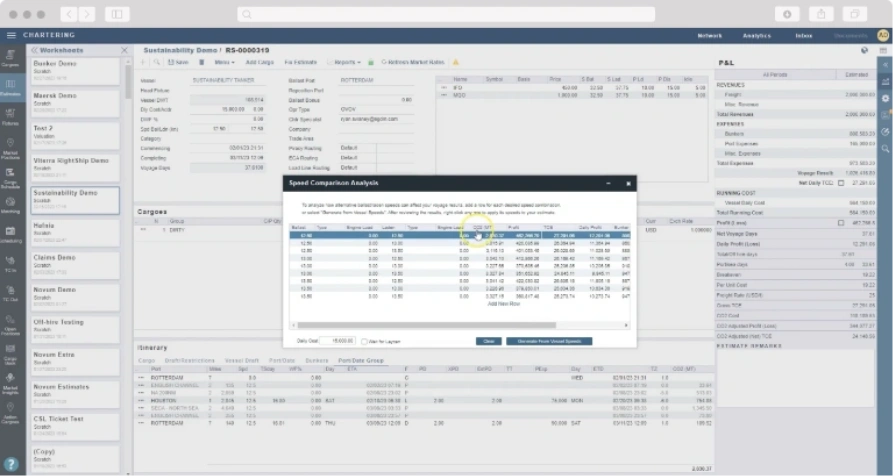How are organizations navigating maritime emissions regulations?
All maritime stakeholders are aware that decarbonization is a critical priority, with intensifying counterparty pressures, industry-wide initiatives like the Sea Cargo Charter, and regulatory guidelines like IMO 2030, EU ETS, EEXI, and CII. But how can you bring emissions considerations into voyage decision-making and account for regulatory guidelines without sacrificing efficiency?
Advancing decarbonization objectives, adhering to EEXI and CII regulations, among others, while maintaining the pace of commerce requires organizations to account for decarbonization in a way that is tightly integrated with their daily operations.
An effective commercial solution will seamlessly bring emissions data, reporting, and carbon calculations into the core contract management workflow, allowing organizations to proactively account for emissions and easily navigate regulations as an integrated part of their daily work.
Top challenges for maritime emissions reduction
Evolving regulations
Over the past several years, we have seen the emergence of several new maritime emissions regulations, including EU ETS, CII, IMO 2030, EEXI, and more. As a result, stakeholders have had to account for new cost considerations, added reporting requirements, and even speed and route adjustments.
Limited emissions visibility
In order to take measures to reduce emissions, maritime stakeholders first require a comprehensive understanding of their current fuel consumption and emissions levels. While most organizations have ways to track this, they often lack the level of detail and real-time monitoring needed to pursue decarbonization in earnest.
Lack of integration
As demand increases, more and more technology solutions have become available to support maritime decarbonization. However, to maintain continuity and effectively consider emissions across the entire workflow, organizations must make sure to select a solution that brings emissions data to the point of decision making.
How Veson supports maritime decarbonization
Together, Veson’s IMOS Platform and powerful data solutions empower maritime shipping organizations to make decarbonization decisions with confidence and align with new regulations.

Comprehensive maritime emissions data
To make the most informed decisions, stakeholders require access to timely and accurate emissions data at the precise stages of the workflow where they are most impactful. Veson’s solutions provide a complete view of vessel emissions, fuel efficiency, trade flows, and more, allowing organizations to plan more effectively and make decisions in pursuit of more sustainable voyages.
Dynamic carbon tracking and calculations
IMOS allows stakeholders to maintain a complete view of emissions, both at the onset of a voyage and throughout its lifecycle. Its integrated carbon emissions calculator accurately evaluates emissions vs. fuel consumption so that stakeholders can fully understand the environmental impact of every voyage.


Integrated regulatory reporting
IMOS streamlines compliance with built-in emissions reports and a report designer to rapidly create custom reports based on the unique needs of your organization. We continuously add new capabilities based on the requirements of our clients and the industry at large, empowering them to comply with confidence.
Financial visibility
Environmental responsibility and economic efficiency go hand-in-hand. With a dynamic view of P&L, IMOS allows stakeholders to assess the immediate impact of environmental decisions, while centrally monitoring profitability over time. In addition, IMOS’ purpose-built trading and risk workspace enables stakeholders to efficiently and effectively manage carbon exposure.

Access our free resources on maritime decarbonization
Fill out the form to receive helpful content from our team of subject matter experts, right to your inbox. We’ll answer questions like ‘What is CII and how does it impact me?’, ‘How can I account for decarbonization regulations every day?’, and more.
Here’s what we’ll share:

BLOG
10 Ways Decarbonization Factors into your Marine Workflow

CAPABILITY SPOTLIGHT
IMOS Emissions Calculator

WEBINAR
Enabling Sustainable Freight Decisions

SOLUTION BRIEF
Solving for EU ETS